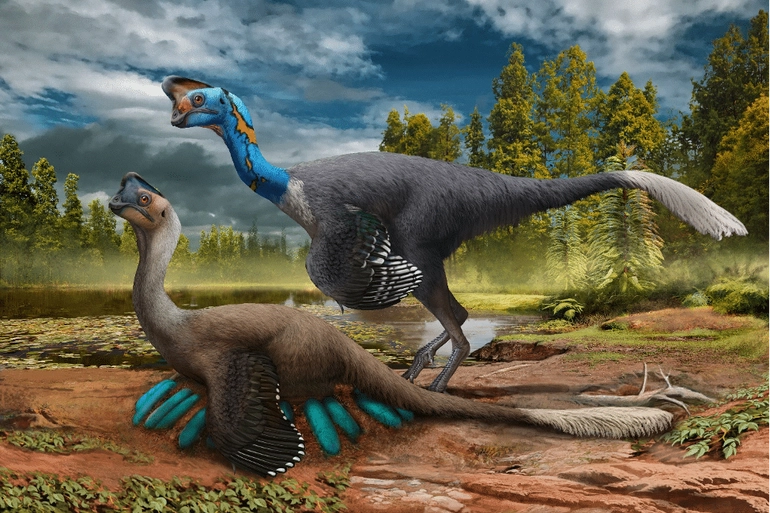
|
| Artwork by Zhao Chuang |
A joint Chinese-American research team has announced a first for the world of paleontology: a dinosaur preserved sitting atop a nest of its own eggs that include fossilized babies inside.
The Oviraptorosaur Family
According to the study published by this team, which was published in the Science Bulletin, this compound fossil was of dinosaurs belonging to the oviraptorosaurs family, a group of bird-like theropod dinosaurs that thrived during the Cretaceous Period, the third and final time period of the Mesozoic Era (commonly known as the ‘Age of Dinosaurs’) that extended from 145 to 66 million years ago.
This family of dinosaurs spread across the continent of Asia, and was characterized anatomically by not having teeth, with parrot-like beak, and about 2 meters long and a height less than 1.5 meters on average , and most of the known oviraptorosaurs were found in the Gobi desert within the lands of Mongolia and northwestern China.
According to the study, The fossil consists of an incomplete skeleton of a large, presumably adult oviraptorid crouched in a bird-like brooding posture over a clutch of at least 24 eggs. At least seven of these eggs preserve bones or partial skeletons of unhatched oviraptorid embryos inside.
But what caught the attention of the team is that the eggs were at the late stage of development of the embryos and the close proximity of the adult to the eggs strongly suggests that the latter died in the act of incubating its nest, like its modern bird cousins, rather than laying its eggs or simply guarding its nest crocodile-style, as has sometimes been proposed for the few other oviraptorid skeletons that have been found atop nests.
To confirm this hypothesis, the team also conducted an oxygen isotope analysis indicating that these eggs remained during incubation at high temperatures similar to what occurs in the case of modern birds.
Moreover, although all embryos were well-developed, some appear to have been more mature than others, which in turn suggests that oviraptorid eggs in the same clutch might have hatched at slightly different times. This characteristic, known as asynchronous hatching, appears to have evolved independently in oviraptorids and some modern birds.
On the other hand, the team discovered a group of small rocks in the stomach area of this dinosaur, and it is assumed that it deliberately swallowed them to help it digest food. If confirmed, it will also be the first time that scientists have discovered the existence of this mechanism in the diet of oviraptorids.
Says Dr. Xu, “It’s extraordinary to think how much biological information is captured in just this single fossil. We’re going to be learning from this specimen for many years to come.”
The team hopes, according to the official statement – published by the Carnegie Museum of Natural History, which is participating in the study – that future examinations of this fossil will help reveal more about the behavior and life of this kind of interesting dinosaur.
Sources:
- https://www.sciencedirect.com/science/article/abs/pii/S5?via%3Dihub
- https://carnegiemnh.org/press/researchers-announce-worlds-first-dinosaur-preserved-sitting-on-nest-of-eggs-with-fossilized-babies/


